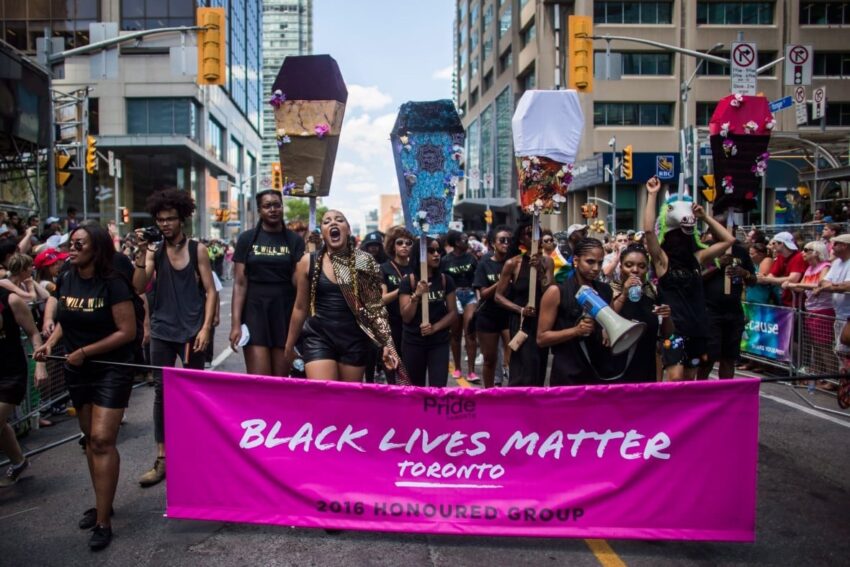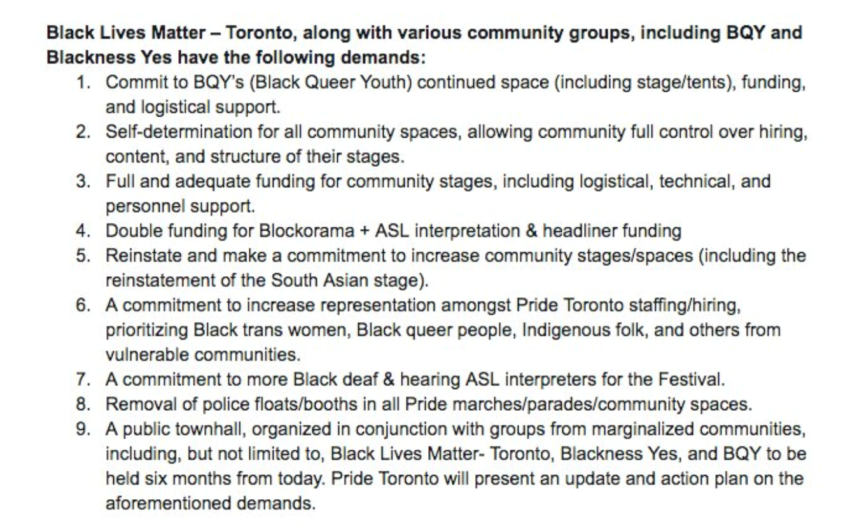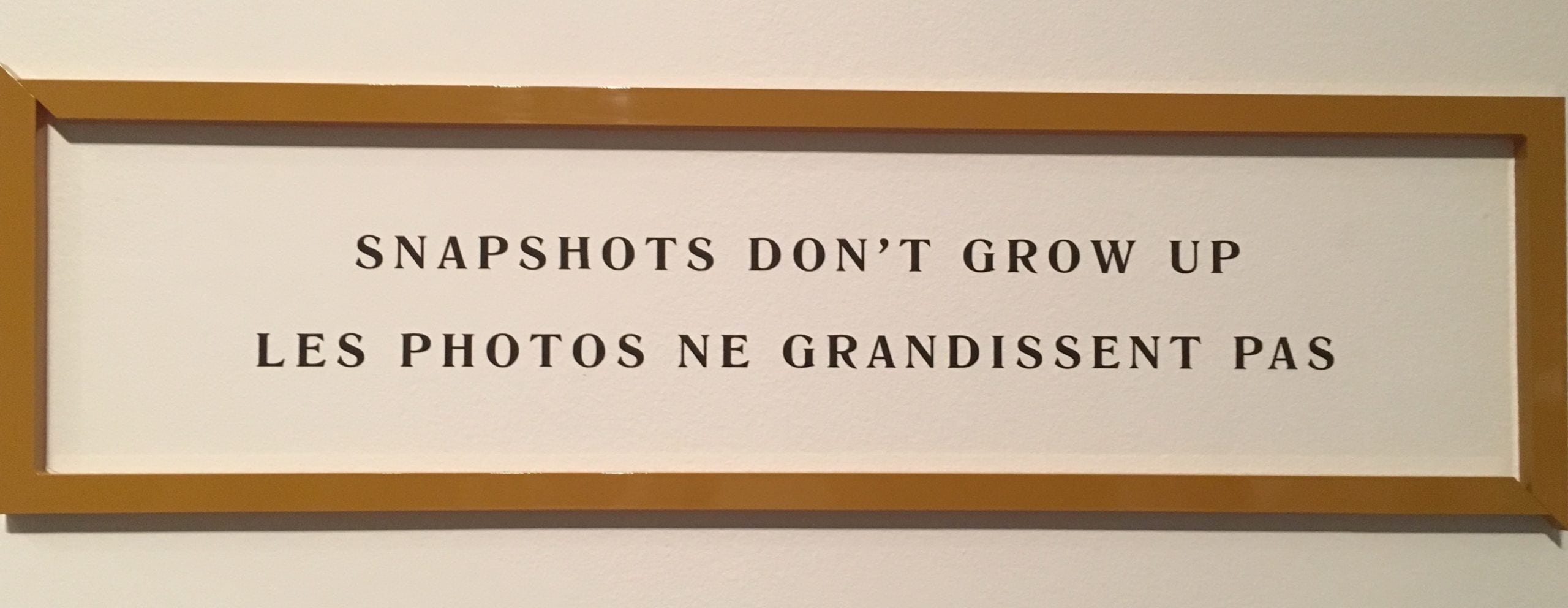
By Jeff Baillargeon
It was only four years ago that Black Lives Matter-Toronto—the honorary group for that year’s Pride Parade—brought the annual march to a halt to speak out against racism at Pride Toronto, and the police brutality IBPOC (Indigenous, Black, and People of Colour) continue to face in Canada.
Providing a list of demands to be accepted for the march to continue to the then-executive director for Pride Toronto, Mathieu Chantelois, the group challenged the community at large to think more critically about how we define queer liberation.

Drawing attention to the lack of representation and financial support for marginalized communities within Pride Toronto, the ongoing police brutality and neglect for communities of colour—specifically queer and trans people of colour as evidenced by the subsequent arrest of Bruce McArthur in the murder of eight queer of colour men—and the lack of funding to create access for disabled people at Pride celebrations, BLM-TO brought attention to the pitfalls of using single-issue approaches to contemporary queer politics. Instead, they forced us to ask ourselves in what ways is queer freedom experienced, or ‘accessed,’ differently when variables such as race, gender-identity, class and location are imported to our analyses. In doing so, as the editors of Queering Urban Justice: Queer of Colour Formations in Toronto eloquently write, BLM-TO’s sit-in “force[d] us to interrogate how spaces of celebration are often forged out of dislocation” (13). That is to say, how spaces of celebration in our city, including but not limited to, Pride Toronto, continue to ‘dislocate’ the ongoing struggles for justice that non-white and low-income queer people still face today.
The group’s sit-in was met with mixed reactions from the crowd at the parade, from shouts of support to shouts requesting the group to ‘move’ as many of the marchers grew impatient. The media, similarly, offered an array of op-eds both justifying the group’s concerns over racial justice and condemning the group’s tactic as a disturbance to the celebration that has become Pride. The central issue, however, was BLM-TO’s demand to Pride Toronto to have police floats and booths removed from future events. This was seen as instilling division in what otherwise ‘should’ be a celebration for inclusion and tolerance. For example, in a CBC article, a Toronto-based political strategist is quoted saying that although the group was successful in reaching the public at large with their concerns, they nonetheless did themselves a “disservice” when “they overplayed their hand and went after the police community.” Causing the most backlash, it is also the demand that has caused the most confusion not only about what the request actually entails, but what warrants the exclusion of the police from Pride in the first place. It is precisely this latter point that demonstrates why BLM-TO’s intervention was, and is still today, four years later, so necessary for our community.
Alexandra Williams, co-founder of Black Lives Matter Toronto, responded to these criticisms by stating that it is “always the appropriate time to make sure folks know about the marginalization of Black people, of Black queer youth, Black trans youth, of Black trans people” (emphasis mine). For many within the community, the legal victories of the past 50 years are indicators that queer liberation is complete (the 1969 decriminalization of homosexuality; the 1995 ruling that section 15 of the Charter includes sexual orientation as a prohibited ground against discrimination; and, the 2005 legalization of same-sex marriage). But, as the group asked of us, in what ways are race, gender-identity, class and location, factors that affect how we access these rights. There is an inescapable discrepancy between the proclamation of law and how it is practiced. For many Black, Indigenous and POC members of the community, discrimination in the workplace is still a reality, discrimination in how police answer calls for help is still a reality, and over-policing is still a reality for many marginalized communities (for a great discussion on this topic, see Professor Robyn Maynard’ Policing Black Lives: State Violence in Canada from Slavery to the Present). For example, the Ontario Human Rights Commission concluded in 2018 that although Black people in Toronto only make up 8.8% of the population, they are present in 7 out of 10 cases of fatal police shootings, thus representing nearly 37 percent of the victims as the independent CBC report concluded. The Commission report also found that Black people, especially men, were overrepresented in investigations into use of force, sexual assault, and inappropriate or unjustified searches and charges.
The demand to remove police floats and booths from Pride events is not a demand to exclude individual queer police officers, but rather a demand to remove the police as an institution symbolizing racial injustice by requesting that symbols of police power such as floats, booths, uniforms, and firearms be banned from the parade. In taking an intersectional approach, BLM-TO is, by default, taking a structural approach to politics. That is, it recognizes that individuals are each unique entities with agency, but that this agency is exercised within and through social codes. Race as a code, for example, is forged out of the power relations between European powers and the peoples indigenous to the countries colonized by the former (a process that is still ongoing), and likewise, queerness is forged out the power relations that have restricted what correct citizenship entails, i.e., opposite-sex couples engaged in a monogamous relationship with the goal of reproduction and ownership of private property, and thus, taxation for the public purse). Individuals become individuals in and through these social codes. Social codes are not inherently oppressive, nor are they something we can escape. They are what allow us to be social, to be individuals negotiating their own individuality vis-à-vis others. BLM-TO, like BLM and other intersectional movements, seek to challenge the institutions that forge, or assist in the forging, of oppressive social codes. The call to remove the police is not an attack on individual queer officers, or officers sympathetic to queer, racial and class struggles, but an attack on the institution as a whole in what it represents historically (emerging from the surveillance of enslaved peoples in the plantations), but also the ways in which it continues to proliferate these practices of surveillance today. After all, Pride emerged in North America as a response to police brutality faced by queer individuals. Citizens’ Independent Review of Police Actions (CIRPA), a coalition of white, Black, and South Asian queers, for example, was central to the early queer liberation movements that emerged in Toronto.
The group’s sit-in—aside from the immediate goal of creating awareness and support for Black lives—was a call to the queer community to re-politicize Pride, to remember our history of police and state violence, as well as the recognition of communities still subject to this violence today, and more importantly, to re-‘member’ the intersectionality central to the early formations of queer liberation groups in Toronto. In bringing the march to a halt, BLM-TO indicated that although we continue to march annually forward in geographical space, temporally, however, we remain at a halt, with Black, Indigenous and POC members of our community waiting for us to recognise this, and to enact the necessary changes for these groups to have the proper funding and power necessary to enact meaningful and lasting change.
https://www.theguardian.com/world/2018/dec/10/toronto-black-residents-more-likely-shot-dead-ontario-human-rights-commission-report
https://www.ctvnews.ca/canada/five-charts-that-show-what-systemic-racism-looks-like-in-canada-1.4970352
https://thetyee.ca/Analysis/2020/06/02/Canada-Race-Based-Violence/
https://www.thestar.com/opinion/commentary/2016/07/07/pride-has-divorced-blackness-from-queerness-cole.html
https://theconversation.com/black-lives-matter-police-and-pride-toronto-activists-spark-a-movement-79089
https://www.newswire.ca/news-releases/black-lives-matter—toronto-halts-the-pride-parade-585378211.html
https://www.newswire.ca/news-releases/black-lives-matter-declare-that-they-have-helped-create-a-more-inclusive-toronto-pride-parade-630727403.html
https://www.dailyxtra.com/how-pride-became-a-business-and-lost-its-soul-along-the-way-80737
https://www.tvo.org/article/why-pride-toronto-handled-black-lives-matter-badly
https://www.cbc.ca/news/canada/toronto/black-lives-matter-toronto-pride-parade-1.3663659
https://www.thestar.com/news/gta/2016/07/03/black-lives-matter-protest-scores-victory-after-putting-pride-parade-on-pause.html
https://nationalpost.com/news/toronto/pride-toronto-votes-to-adopt-demands-from-black-lives-matter-and-ban-police-floats-from-parades
https://www.cbc.ca/news/canada/toronto/pride-parade-toronto-1.3662823
https://newsinteractives.cbc.ca/longform-custom/deadly-force

